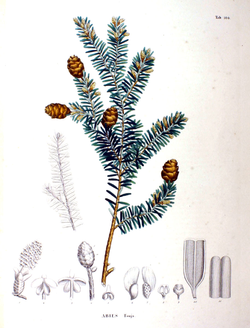Tsuga sieboldii
| Southern Japanese Hemlock | |
|---|---|

| |
| Drawing from 1870 Flora Japonica, Sectio Prima | |
| Scientific classification | |
| Kingdom: | |
| Division: | |
| Class: | |
| Order: | |
| Family: | |
| Genus: | |
| Species: | T. sieboldii
|
| Binomial name | |
| Tsuga sieboldii | |
| Synonyms | |
Tsuga sieboldii, also called the Southern Japanese Hemlock, or in Japanese, simply Tsuga (栂), is a conifer native to the Japanese islands of Honshū, Kyūshū, Shikoku and Yakushima. In Europe and North America the tree is sometimes used as an ornamental and has been in cultivation since 1861.
Description
The tree is often multiple-stemmed from the base and the dense crown is broadly conical and pointed. The bark is a dark pink-grey in colour. It is smooth with horizontal folds when the tree is young, but later cracks into squares and become flaky. The glabrous shoots are a pale shining buff, but they may vary to white or pale brown. The base of the petiole is red-brown. The leaves are densely set in irregular flat rows. They are broad and stubby in comparison to other species of the genus Tsuga, and they vary in length from 0.7 cm to 2 cm long by about 0.2 cm wide. They are blunt with notched tips and shiny dark green above. The underside of the leaves has two broad, dull white stomatal bands. The buds are narrow based and ovoid, dark orange in colour. Their scales are convex.[1]
The stamenate (i.e. male) flowers are terminal on weak shoots. They are very small at only 2 mm, globular in shape and cherry-red in colour. The pistillate flowers are slightly larger at 5 mm, purple in colour and nodding ovoid in shape. The deep dark brown cones are pendulous and ovoid-conic in shape. The tips are blunt and they measure about 2.3 cm long by 1.3 cm wide. Their scales are flat topped.[1]
References
- ^ a b Mitchell, Alan (1974). Trees of Britain & Northern Europe. London: Harper Collins Publishers. p. 146. ISBN 0-00-219213-6.
{{cite book}}: Cite has empty unknown parameter:|coauthors=(help)
